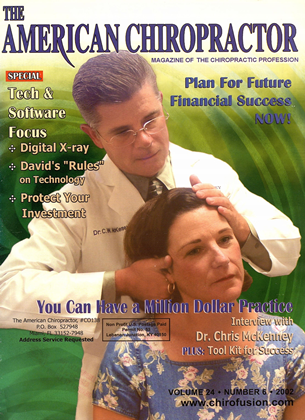T he main values of providing custom orthotics are the postural support, protection, and comfort they offer to your patients. Another important aspect of the orthotics process, however, is the help you can give your patients in getting reimbursed for these products. Many patients hope that their orthotics will be considered a covered expense by their insurance companies. For some policies that is true; but there are exceptions. It is a good idea to suggest that patients read through the various policy documents they were given. If there is no specific exclusion, it is very possible that some coverage is available. Either way, it is often helpful if patients have something in writing which details the reasons you are recommending custom orthotics. This makes them more excited and more willing to pay the cost, even if insurance denies the expense. Sending a copy of this written explanation to the insurance company does seem to help with payment in many cases. Figure 1 is an explanatory letter for custom-fitted orthotics. I recommend you retype this onto your letterhead, and use it whenever a patient, a family member, or an insurance adjustor needs to be educated regarding the need for orthotics. Of course, any specific information you can provide to make the explanation more customized for each individual patient will be very helpful. Your patients will appreciate the "extra mile" you have gone to help them in their dealings with insurance companies. | Dr. John Danchik is the seventh inductee to the American Chiropractic Association Sports Hall of Fame. He is the current chairperson of the United States Olympic Committee s Chiro- Figure I: Rationale for the use of custom-fitted orthotics Custom Orthotics as a Necessary Adjunct to Chiropractic Care for Spinal Conditions Patients who exhibit certain types of spinal problems can benefit from wearing custom shoe inserts (orthotics). These devices help to stabilize the foundation of the pelvis and spine, thereby reducing abnormal stress forces while enhancing the body's functional and structural relationships. When necessary, this office provides custom-fitted, flexible orthotics as an important adjunct to effective chiropractic care. The Fundamentals of Human Blomechanlcs: X. The body is a biomechanical kinetic chain, where abnormal movements at one link, or joint, can interfere with proper movements at other joints. The joints and muscles of the body function most efficiently when they are in physical balance. During standing, walking, and running, our bodies are subjected to natural forces and postures that can inflict mechanical stress and strain throughout the interrelated chain of joints and muscles. When foot imbalance is present, there is a negative impact on the knees, hips, pelvis, and spine. Some patients must have these abnormal forces reduced before they can achieve improved spinal function. Improper Foot Balance and Function Can Lead to: X. Excessive rotation of the tibia and femur, stressing the knee and twisting the pelvis and spine. Tilting ofthe pelvis, which places tension on musclesand connective tissues, eventually resulting in chronic back problems. High levels of heel-strike shock from breakdown ofthe body's natural "shock absorb ers." The shock wave is then carried along the kinetic chain, resulting in painful symp toms up to the head, slowed recovery of leg and spine injuries, and aggravation of other muscular conditions. Misalignment of vertebrae and a functional scoliosis, which can develop into a painful, chronic spinal arthritis condition. The Benefits of Custom Orthotlc Support: X. Properly fitted orthotics support the foot to control excessive pronation and supination, preventing unwanted stress on the body. Limiting functional hypermobilityof the foot and leg helps chiropractic adjustments hold longer and increases the effectiveness of chiropractic care. Improved shock absorption reduces repetitive stress on joints and muscles, permitting smoother function and decreasing arthritic symptoms. Use of orthotics represents a long-term, yet cost-effective, intervention for many types of functional and structural musculoskeletal problems. Orthotic therapy is a standard treatment modality for comprehensive case management, is widely recognized throughout the profession, and is taught as an integral part of most chiropractic college curriculums. How Orthotics Work: X. Wearing orthotics inside shoes is similar to placing a shim beneath the leg of a wobbly table; it adds support to eliminate unwanted motion in the entire structure. The foot is formed of three distinct arches, which create an architectural "vault." The result of orthotic support for these three arches is improved stability and postural integ rity. Flexible orthotics encourage optimal muscle and nerve function by guiding the foot through a more normal pattern with each step taken. About Specialized Custom Orthotics: X. The laboratory we use, , a leading supplier for more than years, creates custom-made, flexible orthotics to match each patient's unique postural needs. Using three-dimensional impression images of the weight-bearing foot (in the position of function), along with instructions from the healthcare professional, skilled laboratory technicians create unique orthotics designed to correct and support areas of weakness. The combination of flexible yet supportive and durable construction materials ensure that the orthotics will both guide the foot when walking, and provide support for the foot during long periods of standing. Unlike some previous orthotic technologies, which use rigid materials to force the foot into a theoretical "ideal" position and which may result in muscle atrophy and abnormal nerve proprioception, the orthotics we use allow controlled, supported movement for the dynamic human body. Submitted as clarification of clinical procedures by: [Doctor's name], [Clinic name] practic Selection Program. He lectures extensively in the United States and abroad on current trends in sports chiropractic and rehabilitation. Dr. Danchik is associate editor to the Journal of the Ncuromusculoskcletal System and the Journal of Chiropractic Sports Injuries and Rehabilitation. He has been in private practice in Massachusetts for 24 years. You may reaach Dr. Danchik at (617) 4H9-I220 or e-mail docforjocsCakiol. com
 View Full Issue
View Full Issue









